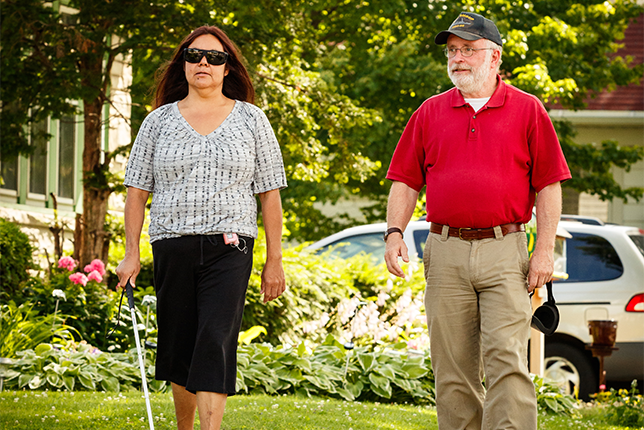Program Spotlight: Orientation & Mobility Services

Posted In Categories: Programs & Services
Helping individuals with vision loss learn how to travel the world safely.
Certified Vision Rehabilitation Therapist (CVRT)/Certified Orientation & Mobility Specialist (COMS), Steve McAuliff, provides insightful direction.
It is a bustling, sunny spring day in the city. After a long, snowy winter season in Wisconsin you decide to take a refreshing stroll to the local coffee shop. Neighbors smile at you and share friendly greetings. Bicyclists stream pass you on the left as the cars fly by on the right. Standing at the corner of a busy intersection you wait for the light to change and the walk signal to appear. Now imagine taking this journey with your eyes closed.
Teaching individuals how to take that journey with little or no vision is what Steve McAuliff’s job is every day at Vision Forward.
What does Orientation and Mobility mean?
Orientation is the ability to know where you are in space in relation to people, objects and your destination. Mobility is the ability to move from point to point safely, efficiently and effectively. Orientation and Mobility training is often necessary when a person loses significant vision.
What is the impact of O & M training?
The level of independence mobility can provide an individual is extremely impactful. Whether that independence is simply being able to go down to their corner store, take the bus to work, or visit a friend. People no longer feel they are captive in their own homes or totally dependent on others to take them places.
O & M (Orientation & Mobility) is all about empowerment and with the proper tools and training, confidence and independence can be achieved.
An Overview of the Training Process
- An assessment is done to determine a client’s goals and skill level as well as type and duration of training.
- Client learns the basics of proper cane grip and learning the correct width when arcing the cane while walking.
- Client learns ascending and descending stairs, shore lining and staying in step.
- Outdoor training includes using environmental cues and nonvisual landmarks to keep oriented and using sound to analyze and cross at light-controlled intersections.
- Finally, crossing streets at uncontrolled intersections, reversing routes and reaching destinations without instructor cues, bus travel, train travel, and route planning.
